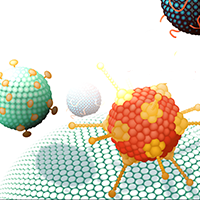Merits of non-viral cellular engineering versus viral cellular engineering
Cell Gene Therapy Insights 2018; 4(2), 113-117.
10.18609/cgti.2018.018
What options exist for cellular engineering, and why are some methods used more frequently than others?
It’s what people have been doing since the 1950’s when cell culturing began. The addition of growth factors, serum, or other components to media is what helped to modify cells and push them towards the desired states or lineages.
A more targeted approach is to directly engineer cells by introducing genes, for either temporary or permanent expression. This is most commonly accomplished with viruses, which are biologically designed to deliver genes into cells. However, there are non-viral approaches such as electroporation, where an electrical field is applied to the cells causing the cell membrane to temporarily open, and allowing whatever molecule is outside the cells to enter.
The primary driver for choosing the route of cellular engineering is the answer to the fundamental challenge of whether the gene being delivered will be permanently or temporarily expressed in the engineered cell therapeutic product. For the most part, viral-based delivery of genetic material is likely to result in the integration of the delivered genes into the cell. This is particularly true for lentivirus-based viral vectors. Integration of foreign genetic material can also be achieved with non-viral delivery of DNA plasmids or transposon systems such as Sleeping Beauty.
Alternatively, non-viral delivery is most readily achieved when delivering mRNA as human cells are much less sensitive to the presence of foreign mRNA as they are to foreign DNA. The mRNA will not integrate, meaning that the gene will be transiently or temporarily expressed, rather than permanently integrated into the cell genome. And, there is a viral answer to this as well! Adenovirus and AAV do not result in integration so the expression of genes introduced by Adenovirus or AAV will also be transient.
Can you expand upon the process of electroporation and its potential applications in this field?
Interestingly, our technology can also enable the engineering of viral vectors. This may sound ironic given this conversation is centered around the benefits of using non-viral approaches to cellular engineering, but, electroporation can also be used to engineer the cells that produce the viruses. When building a viral vector, the production typically requires either a lipid-based or electroporation-based transfection of nucleic acids into virus-producing cell line. So, for companies who are dedicated to using viruses and struggling to identify a manufacturing slot, it’s worth noting that using our Flow Electroporation® technology for engineering of viruses could be another risk mitigation strategy.
For anyone interested in doing gene therapy and who is right now thinking about using a viral vector, my advice would be to first secure your manufacturing slot and plan according to that timeline. But, while you’re waiting for your manufacturing slot and working on additional aspects of the process development, it makes sense to explore non-viral options at the same time.
Within only a year, it’s possible to have a clinic-ready process using electroporation, specifically with MaxCyte’s technology. This non-viral approach makes a lot of sense as a parallel process to the development of a process employing viral vectors, especially when time is a critical factor. Companies could be ready for clinical testing of their cellular therapies before their viral manufacturing slot even comes up. We’ve seen a lot of our partners start with a research process and end with a clinic-ready process within a years’ time.
We’ve heard a great deal about GMP-grade viral vector manufacturing becoming a bottleneck in the industry. Can you share your thoughts on why this has become an issue, and how it could impact the timeline of clinical development of these therapies?
There has been an explosion in the gene therapy space with more therapies being developed by companies, bringing a lot of innovation. This expansion is great and exciting for the field, but has also resulted in an overwhelming demand for GMP-grade viral vectors. In about the last 6 months, there’s been a growing appreciation for the lack of manufacturing slots at CMOs for producing clinical-grade viral vectors.
Both industry news and mainstream media outlets, such as the New York Times, have been reporting on the lack of viral vector manufacturing capabilities around the world. The attention that this shortage is getting speaks to how concerned people are about being able to manufacture the viral vectors they want to use for their gene therapies.
According to these news outlets, most contract manufacturing organisations (CMOs) are booking about 18 months out or longer. This means that anyone who has decided they want to develop a viral-based gene therapy today, would have to wait at least 18 months for production time at a manufacturer in order to have the virus made. Then, once the viral vectors are made, they need to go through extensive testing to ensure that they’re safe, which can take another 6-9 months. So, adding up the time spent waiting for the manufacturing slot, manufacturing itself, and testing of the viral vectors, companies will wait at least two years before they could have a virus for use in validation studies of their engineered cell product.
When taking into account this lack of manufacturing capability, the testing of viruses to ensure safety, as well as the high cost of licensing for the viral vectors from patent holders, companies are starting to seek alternate cellular engineering modalities in addition to viral vectors.
Do you find when working with new clients that there’s a need for initial education regarding what electroporation technology entails?
It’s funny you ask that, because recently I’ve had people say “isn’t that what I used to fry my cells with back in grad school, back in the day?” My response was that not all electroporation is created equal!
Our technology was designed with ‘clinic ready’ technology in mind. Everything about our technology, consumables, and process is clinical grade and designed to be gentle and effective with the cells. This includes both our proprietary chemically-defined buffer and our proprietary electrodes which, together, ensure the gentle and effective engineering of therapeutic cells. To that end, our results are highly reproducible, which is critical for GMP. There is great consistency from batch to batch, which is necessary for clinic readiness and translating a research process to a batch record that can be executed for generations of patient samples. Furthermore, MaxCyte’s technology scales seamlessly so that any optimization work at small scale translates easily to large scale with no re-optimization.
We also have a very strong team of experienced scientists working on each project, directly with our partners to help them optimize their process. It’s really the expertise we bring in addition to the technology itself that helps people achieve a viable product within a years’ time.
What would be the impact of a serious viral-related serious adverse event in clinical or commercial administration of viral-based gene therapy products, in your opinion?
First of all, that would be terrible and we all hope that never happens. But, just like any market our industry is not immune to public perception and fear. I think there would be a lot of concern for the safety of these types of therapies. For instance, there was a study released last month that reported the death of several monkeys in a high dose AAV study. As a response to this news, a couple of in vivo gene therapy companies saw their stock prices fall. This sensitivity in our field isn’t surprising, given that we are an immature market.
To mitigate the risk of adverse events centered around viral vectors, companies should consider alternate strategies in the pipeline in order to demonstrate to the markets, investors, and patients who are desperately waiting for these therapies, that they have a comprehensive product development strategy.
How do you see the field of gene therapy evolving over the next 5-10 years?
There was an exciting wave of product approvals that we all observed in 2017, and I think there will be additional approvals coming in 2018, as well as some exciting phase III results that a lot of us are anticipating. I think this will be a theme that continues over the next few years and that the majority of what we’ll see coming to market will be viral vector modified products. But, at some point within 5–10 years, I believe we will see products engineered with non-viral methods, such as electroporation, that will also make it to market. And I think the market will respond well to that.
When non-viral methods are used in products that make it to the market, I think it will be a trend that will quickly gain momentum. So, for companies contemplating whether it’s the right time to employ non-viral approaches to their pipeline products, I would say that it’s a smart idea. We’ve already seen the first wave of viral modified products coming to market, but I think there will be a transition to non-viral within the next decade.
Affiliation
Dr Jessica Carmen
Director of Strategic Marketing for Cellular Therapy, MaxCyte, Inc.![]()
This work is licensed under a Creative Commons Attribution- NonCommercial – NoDerivatives 4.0 International License.


